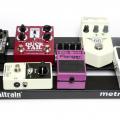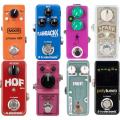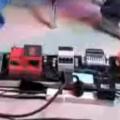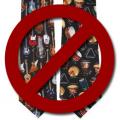I’m writing this post today because I’ve been finding myself having this conversation lately with a variety of guitarists. I thought it might be a good talking point for today.
So I know a lot of you already of have pedalboards. But there is also a large amount of guitarists out there that are board-free and run effects loose on the stage. Typically, going with a pedalboard is a commitment of sorts. Boards aren’t cheap and it might feel like a lateral movement in a way – paying for something, and not immediately seeing the gain or direct need.
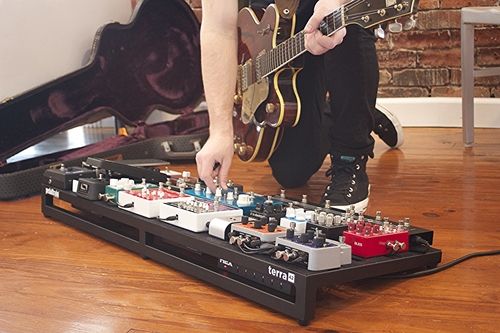 When I suggested to someone that they might want to think about investing in a board set up, I was immediately asked “why”. The person had a handful of pedals (4-5) and didn’t see the benefit at all, and that got me thinking – maybe we should break down some of the benefits for going to a pedalboard set up.
When I suggested to someone that they might want to think about investing in a board set up, I was immediately asked “why”. The person had a handful of pedals (4-5) and didn’t see the benefit at all, and that got me thinking – maybe we should break down some of the benefits for going to a pedalboard set up.
Why should you get a board?
Speed. On my early post “PSA: Don’t be a douchebag band” I talked about getting on and off the stage quickly. With a pedalboard set up you can simply unplug a pair of instrument cables, potentially a power cable and you’re pedals are packed. With loose pedals, you find yourself individually packing up pedals, that eat up valuable time.
Patch Cables. This is something that people don’t consider – the lifespan of your patch cables. When you have loose pedals you’re plugging and unplugging your patches. Those patches are twisted and stretched as the pedals get kicked around the stage. By having pedals mounted on the board, the patches do NOT move and hold up much better. Granted, there can be issues with solderless patches on boards, so this problem isn’t 100% solved by going with a board… but in my opinion, a set of soldered patch cables on the board increases their lifespan.
Pedal Care. Similar to the patch cables, the lifespan of the pedals are better as well. I’ve seen loose pedals get thrown in a duffle bag at the end of the gig. Pedals bouncing around will eventually lead to broken knobs. The constant plugging/unplugging can also result in loose or spinning jacks which can eventually lead to failure. Locking those pedals down, and stored – preferably in a hardshell road case keeps those pedals healthy.
Power. Man, I love this part. Typically, players that have loose pedals will default to a One-Spot daisy chain to power the pedals from the tuner. I did that for years back in the day. Those daisy chains can be a nightmare from unused barrels shorting/shocking you from mic stands, to potentially harming pedals when contacted. And most typically.. daisy chains can be very noisy. When you get to a board set up, this is a great opportunity to go up to a mounted isolated power supply. Granted, this is another investment, but something you can go to down the road.
Space. I often get told that they don’t need a board because they have 4-5 pedals. But getting a board that has room to grow is a great opportunity to test new pedals and allow you to easily reorganize your line depending on your needs. Remember, you don’t need to jump to a large board. There are plenty of sizes and layouts that are available.
Pedalboards
So we talked about the benefits, but what is a good board set up for you? Lots of people will immediately jump to the – “I’ll just build something myself to save on cost”. That’s great. If you have the means and the ability to create one, by all means, do it. But, if you’re not sure, you really have to consider the time involved. Material can be more than you think, and in the end you might actually pay more building your own than purchasing something.
When you look at boards, I would look at a few attributes first.
- Do you want multiple rows? If you’re going from loose pedals, you’re probably use to having them in a line, but rows are great for getting some pedals out of the way that you don’t use often and the most used closes to you.
- What size do you need? I always recommend going a little bigger than what you need. You don’t want to outgrow your board with your next purchase.
- Angle or Flat? Some guys like an angled boards while others want them flat on the stage. Please remember, if you go flat, that means you’ll need to eat real estate if you want to add a power supply. Angled boards can have the power underneath.
- Pedal mounting options. There are plenty of ways to securing your pedals from a flat surface, to rails, to using zip ties, etc.
- Packing options – does it come with a gig bag, a lid, or a hardshell case
So there are plenty of brandnames to choose from.
I’ve been using Pedaltrain for years. They are extremely easy to mount pedals and route cabling. Plenty of room for power supplies, etc. My main board also has a ATA flight case, which is absolutely critical for touring. There also is a large selection of sizes and options.
Diago makes a great set of boards with mountable hard lid. They are flat board, and very low profile. I’ve seen Diago boards on a lot of Pedal Line Friday posts in the past.
Chemistry Design Werks is an interesting multi-tier board that allows for zip tie mounting. Some players hate the thought of adding velcro to their pedals and this is a great option for those.
Going more boutique, you could look at a company like Salvage Custom that makes absolutely BEAUTIFUL boards. They’re not cheap, but amazing. There are many boutique builders out there to pick from.
As you can see, plenty of options out there. There are a lots of benefits to get the pedals on the board. Let me know if I missed anything by commenting below!

